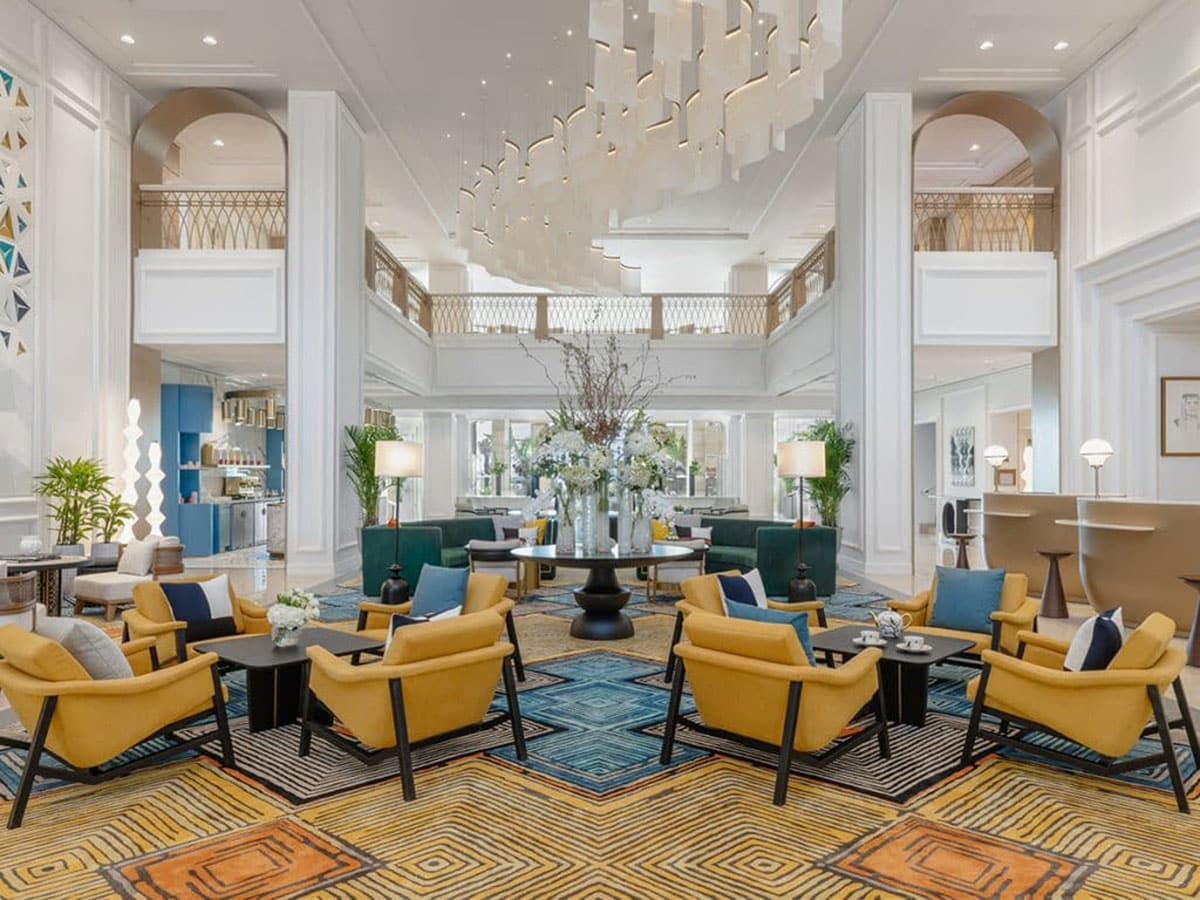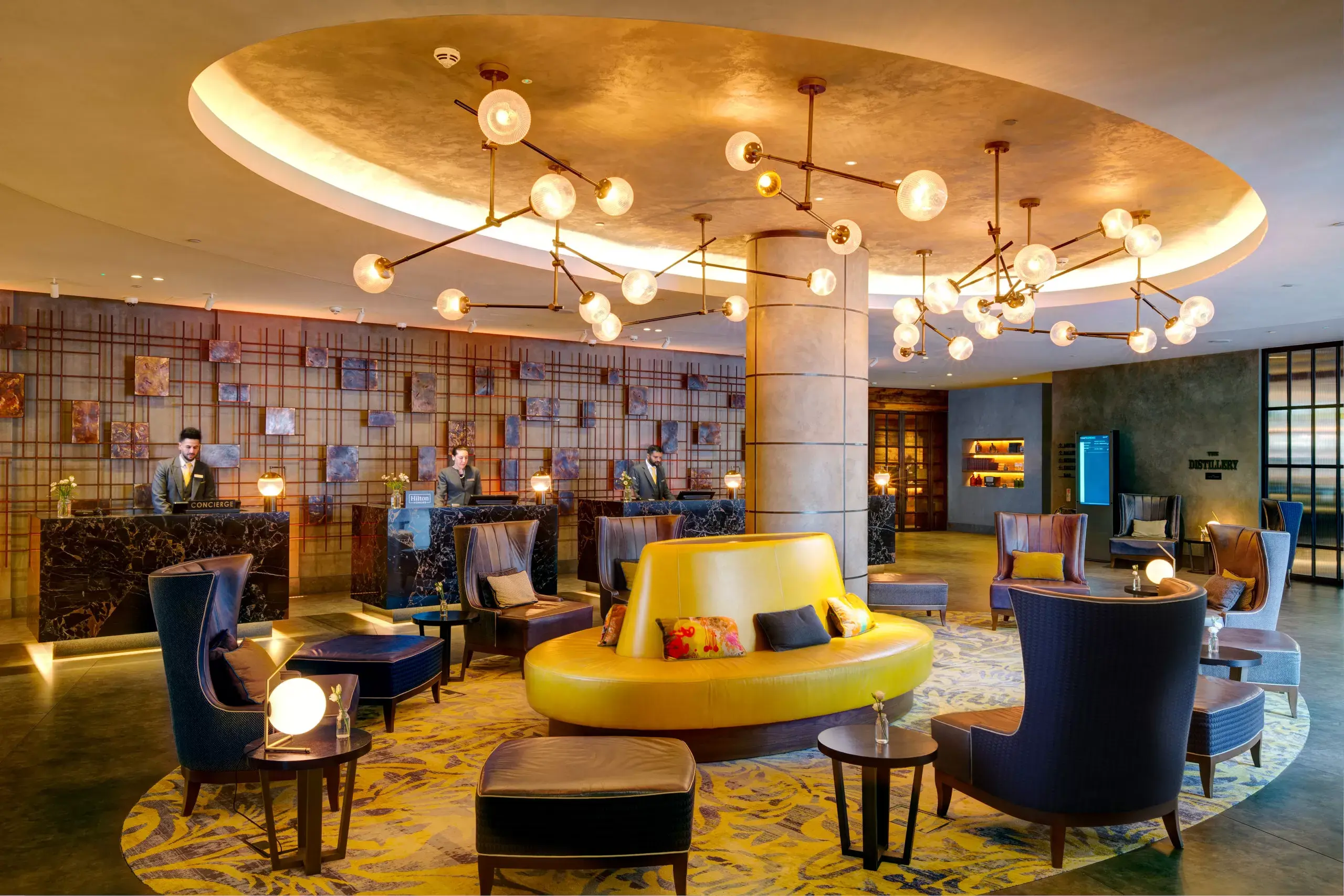Fohlio is a comprehensive specification and procurement tool that helps users take on larger projects. Empower teams to open stores faster and improve their operational workflow with specification, prototyping, estimating, and procuring tools.
The Story Every Hotelier Knows (and Hates)
It starts with good intentions.
Your flagship property is finally getting that much-needed refresh. The new mood boards are stunning. The procurement team is ready to go. Operations has a plan to minimize guest disruption.
Fast forward a few months. You walk into the “new” lobby and… something feels different. Not bad. Just… not you.
The warm brass sconces have been replaced with a brushed nickel “upgrade.” The velvety armchairs are now a microfiber “that’s basically the same.” The marble flooring? Technically still marble — just a slightly different veining pattern than you remember approving.
Guests won’t say “This is off-brand.” They’ll just feel it. And that’s the danger.
Welcome to brand drift: the slow, almost invisible slide away from the identity you’ve worked so hard to build.
What Brand Drift Looks Like in Real Life
Brand drift isn’t always obvious. It’s rarely a full design overhaul that breaks consistency. More often, it’s death by a thousand substitutions:
-
Lighting temperature swap: 2700K bulbs replaced with 3000K. The space feels sharper, less cozy.
-
Fabric texture change: That high-end boucle sofa becomes a smooth weave. The tactile richness disappears.
-
Finish mismatch: One bathroom renovation swaps brushed brass fixtures for polished chrome because they were “easier to source.”
Each change is small enough to justify — until you step back and realize the soul of the space has shifted.

Image reference:
Think about the difference between walking into a Hilton Bankside Lobby with its signature, cohesive palette versus a property where every renovation was handled “locally” without a central standard. The first feels intentional. The second feels… patched together.
Why Renovations Are Prime Time for Brand Drift
Renovations are messy. Not just physically, but operationally:
- Multiple stakeholders: Design, procurement, finance, operations, contractors, and vendors are all making calls.
- Tight timelines: When a supplier misses a delivery, “close enough” becomes tempting.
- Budget pressure: Cost-saving swaps can sneak in without anyone realizing the visual impact.
- Product availability: Discontinued SKUs force substitutions on the fly.
Without a way to keep everyone aligned, each department is making decisions based on their own priorities. That’s how the “design intent” that wowed in the planning phase gets watered down by install day.
The Real Fix: Get Everyone in One Place
Here’s the truth:
Most brand drift isn’t caused by bad choices. It’s caused by good choices made in isolation.
Design is thinking about the mood. Procurement is thinking about lead times. Finance is thinking about cost. Operations is thinking about durability. All valid concerns — but without a central, shared system, they’re not part of the same conversation.
When your teams aren’t connected:
- Procurement swaps to an in-stock chair without knowing it clashes with the lobby’s wood tone.
- Finance approves a cheaper light fixture that throws off the intended ambiance.
- Operations replaces worn carpet with a “similar” pattern that’s just slightly off.
When your teams are connected in Fohlio
- Everyone sees the same approved specs, with photos, vendor info, and context.
- Any proposed change triggers a design review before it’s locked in.
- All approvals are logged, so there’s no guesswork later.

It’s like putting the entire renovation project in one war room — except no one’s shouting, and everyone actually likes each other at the end.
Step 1: Make Brand Standards Impossible to Lose
A PDF brand guide is great for training. It’s useless for active projects if it’s hidden in someone’s inbox.
Your approved finishes, fixtures, and furniture need to live in the same system your teams use to work — accessible in real time to everyone involved.
How Fohlio does it:
- Build a centralized materials library with every approved product, complete with photos, vendor details, pricing, and lead times.
- Tag items with brand standard categories so they’re easy to find and filter.
- Allow only pre-approved specs to flow into procurement requests.

Image reference:
Picture a luxury hotel lobby where every element — from the flooring pattern to the upholstery texture — feels like it was chosen by the same hand. That’s not luck. That’s a locked-down materials library.
Read: The Backbone of Better Design: Fohlio’s Product and Materials Library
Step 2: Keep the Context with the Specs
Hospitality design is all about relationships — not people, but materials. A fabric swatch looks one way in your hand and another way under the actual lobby lighting.
In Fohlio, you can:
- Link mood boards directly to specs so teams see how materials work together.
- Include photos of past installations to show real-world context.
- Maintain pre-approved alternates so substitutions happen without brand compromise.
That means when procurement needs to pivot, they’re pulling from an alternate you’ve already vetted for brand fit — not guessing from a thumbnail in an online catalog.

Image reference:
Sofitel Al Hamra by Kristina Zanic Consultants where every texture, tone, and shape feels intentional. That’s context preserved.
Step 3: Centralize and Track Approvals
Approvals scattered across email threads are where brand intent goes to die.
In Fohlio:
- Stakeholders approve items inside the platform, with visuals, details, and context all visible.
- The system logs who approved what and when.
- You can pull up the approval history years later — invaluable when replacing assets or justifying decisions.
This isn’t about micromanaging — it’s about creating a transparent chain of custody for every design choice.

Reference: Track approvals in Fohlio. See time stamps of history of edits and easily leave comments.
Step 4: Tie Procurement Directly to Design
Here’s where most drift sneaks in: Procurement works from a separate spreadsheet, outside of design oversight. That’s when a “similar” barstool makes it onto the loading dock.
With Fohlio:
- Procurement pulls RFQs straight from the approved specs.
- Any change request alerts the design team immediately.
- Operations sees the same data, so installation matches the original intent.

Reference Image: Set up a dashboard view per team inside Fohlio. Easily work on the same, real-time data.
Read: Smarter Purchasing Made Simple: Fohlio’s Procurement Tools
Step 5: Track Every Asset for the Long Game
The renovation doesn’t end when the last piece of furniture is placed. In hospitality, you’re constantly replacing, repairing, and upgrading — and if you don’t know exactly what’s in place, consistency is gone.
Fohlio’s asset tracking:
- Tags every installed item with location data (room, floor, property).
- Stores warranty, maintenance, and reorder info with the original spec.
- Runs cross-property reports so you know exactly where each item lives.
That means if a sconce in your Miami property breaks, you can reorder the exact same one that’s in your LA property — no guesswork, no drift.
Read: Fohlio FF&E Revit Integration: Cut Errors, Save Time, and Simplify Specification
Step 6: Prototype Before You Roll Out
One of the fastest ways to stop brand drift in its tracks is to see the renovation before it happens — and I don’t mean squinting at a flat floor plan or flipping through fabric swatches under office lighting.
Prototyping isn’t just for product design. In hospitality, it’s your insurance policy against “We didn’t realize it would look like that.”
Here’s why it matters:
- Visual confirmation: You can see exactly how the new finishes, fixtures, and furniture work together in real space.
- Stakeholder alignment: Everyone — from design to procurement to operations — gets a shared, physical or digital reference point.
- Course correction: If something feels off, you can fix it before it’s multiplied across dozens or hundreds of rooms.

Image reference blurb:
A snapshot of Fohlio’s Product Blocks library, showing how every room type from Queen Suite to Lobby is pre-assembled with approved products, finishes, and styles, complete with vendor data and costs. By storing prototypes like this in one central library, design, procurement, and operations can all pull from the same brand-approved template, ensuring what you prototype is exactly what gets rolled out across every property.
How to prototype in a way that actually prevents drift:
- Build a model room or space. This can be a single guest room, a section of the lobby, or even a public restroom if that’s what’s being renovated.
- Use the real specs from your Fohlio library. Don’t settle for placeholders — test the exact finishes and furniture that will be used.
- Photograph and document everything in Fohlio. Those photos become part of the project record, so when it’s time to execute at scale, every contractor and vendor has a visual blueprint to follow.
- Invite cross-functional feedback. Give design, procurement, operations, and finance the chance to walk the space together and sign off in-platform.
Read: Pre-Bundled Templates & Seamless Estimating for Faster Projects
The Unified Renovation Workflow
Here’s how this plays out in real life:
Pre-Renovation
- Audit your materials library in Fohlio.
- Flag discontinued items and upload approved alternates.
- Share the updated library with all teams in-platform.
During Renovation
- Lock procurement to approved specs.
- Require in-platform approvals for every change.
- Link all orders to the original spec for traceability.
Post-Renovation
- Tag every installed item in the asset tracker.
- Upload as-built photos.
- Set reminders for warranties and maintenance schedules.
Read: 6-Steps on How to Build a Global Spec Management System That Keeps Products, Pricing, and People Aligned
The ROI of Keeping Everyone Together
When all your teams share the same platform, you’re not just protecting aesthetics — you’re protecting the bottom line.
- Guest loyalty stays high because the experience is consistent year after year.
- Operational friction drops because you’re not constantly re-sourcing or re-approving.
- Asset value holds because every upgrade reinforces your positioning instead of diluting it.
And perhaps most importantly? You stop having that sinking feeling when you walk into a renovated space and realize something’s off.
Brand drift is sneaky. It doesn’t announce itself — it just quietly chips away at the identity you’ve spent years building. But when design, procurement, operations, finance, and vendors are all working in the same place, with the same information, you make it almost impossible for drift to sneak in.
Fohlio doesn’t just keep your specs organized. It keeps your brand safe — one renovation, one property, one asset at a time.
Fohlio is a comprehensive specification and procurement tool that helps users take on larger projects. Empower teams to open stores faster and improve their operational workflow with specification, prototyping, estimating, and procuring tools.
